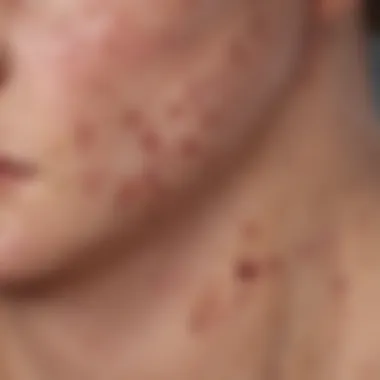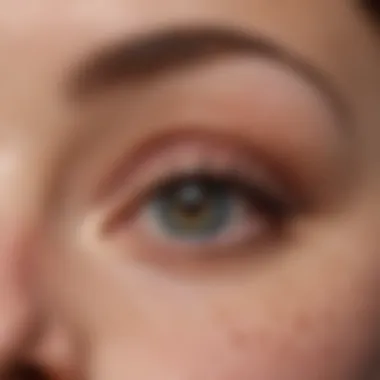Chronic Cutaneous Lupus Erythematosus: A Comprehensive Overview


Intro
Chronic cutaneous lupus erythematosus (CCLE) stands as a significant form of lupus that primarily targets the skin. This article aims to provide a comprehensive overview of CCLE, detailing its clinical features, diagnostic obstacles, treatment options, and management strategies. Understanding CCLE is essential not only for healthcare professionals but also for individuals grappling with the implications of this autoimmune condition.
Key Concepts and Terminology
Definition of Key Terms
To navigate the complexities of CCLE, it is crucial to understand the following terms:
- Lupus: A chronic autoimmune disease that can affect multiple systems in the body, including the skin, joints, and internal organs.
- Cutaneous: Pertaining to the skin. In this context, it refers to the skin manifestations of lupus.
- Chronic: A long-lasting condition that persists over time.
Concepts Explored in the Article
This article will explore important concepts like:
- The pathophysiology of CCLE
- Common symptoms and clinical features
- Challenges in diagnosis
- Treatment modalities
- Implications for patient management
Findings and Discussion
Main Findings
The nature of CCLE includes several key findings:
- Clinical Features: CCLE typically presents with distinct skin lesions, which can differ in appearance and severity. Most lesions are often found on sun-exposed areas.
- Diagnosis: Diagnostic challenges arise due to the overlapping features of other skin disorders. It often necessitates a thorough clinical assessment and may include biopsies for confirmation.
- Treatment: Management strategies combine topical therapies, systemic medications, and lifestyle modifications. These are guided by individual patient needs and disease severity.
Potential Areas for Future Research
Future research can delve into several areas:
- Understanding the genetic factors that contribute to susceptibility
- The exploration of innovative therapies that target autoimmune responses more effectively
- Longitudinal studies to assess the long-term impact of CCLE on quality of life
"A comprehensive understanding of CCLE will lead to better patient outcomes and targeted therapeutic strategies."
In summary, engaging with the nuances of chronic cutaneous lupus erythematosus is vital for both healthcare professionals and informed readers. The complexity of this condition requires thorough exploration and ongoing research efforts to enhance patient care.
Overview of Chronic Cutaneous Lupus Erythematosus
Chronic cutaneous lupus erythematosus (CCLE) is a significant dermatological condition that demands thorough understanding for effective management and treatment. Its implications extend beyond the skin, affecting various aspects of a patient’s life. This overview serves to establish the relevance of CCLE within the larger context of lupus and dermatological disorders.
Understanding CCLE is crucial for timely diagnosis and intervention. The unique features of this condition can lead to severe psychological impacts, hence emphasizing the need for comprehensive knowledge on its clinical presentation and management strategies.
Defining Chronic Cutaneous Lupus Erythematosus
Chronic cutaneous lupus erythematosus is a lupus erythematosus subset primarily impacting the skin. Unlike systemic lupus erythematosus, which can affect multiple organs, CCLE is largely confined to cutaneous manifestations. Patients often experience a variety of skin lesions that can be persistent and challenging to treat. It is characterized by well-defined, erythematous plaques that may become scaly or atrophic with time. While the exact cause remains unclear, an interplay between genetic predisposition, immune dysregulation, and environmental factors is thought to contribute to its development.
The disease requires careful assessment to identify clinical features accurately. Misdiagnosis or delayed diagnosis can lead to inadequate treatment, which can exacerbate symptoms and result in more significant long-term effects on the patient's wellbeing.
Epidemiology and Incidence
Epidemiological studies highlight that CCLE is more prevalent in specific populations. Women are disproportionately affected, particularly those between the ages of 20 and 50. Studies suggest that the incidence rate ranges roughly between 2 and 10 cases per 100,000 individuals annually, a figure that can vary internationally based on ethnicity and environmental conditions.
Certain factors may contribute to the higher incidence in particular demographics. For instance, exposure to ultraviolet light, particularly among fair-skinned individuals, has been associated with increased risk. This can lead to greater awareness of protective measures necessary for those at risk. Moreover, other autoimmune disorders may share common pathways with CCLE, further complicating the epidemiological landscape.
In summary, understanding the epidemiology of CCLE helps in developing targeted awareness and management strategies. It also underscores the importance of regular screenings for at-risk populations, aiming at early intervention and improved patient outcomes.
Pathophysiology of CCLE


Understanding the pathophysiology of chronic cutaneous lupus erythematosus (CCLE) is vital for comprehending how the disease manifests and progresses. This knowledge helps healthcare professionals tailor treatment and management strategies specific to this skin condition. The pathophysiological mechanisms involve a complex interplay of immune responses, genetic predispositions, and environmental influences that contribute to skin lesions and other symptoms experienced by individuals affected by CCLE.
Immune Response Mechanisms
The immune system plays a crucial role in CCLE. In normal conditions, the immune response protects the body from infections and foreign pathogens. In lupus, however, this response becomes dysregulated. This dysregulation leads to the activation of autoreactive B and T cells, resulting in the production of autoantibodies. Autoantibodies target the body's own tissues, leading to inflammation and damage. In CCLE, specific autoantibodies can cause localized inflammation in the skin, resulting in lesions that often have characteristic appearances, such as erythematous plaques or scaling.
Cytokines are also important in CCLE's immune response. These signaling molecules mediate inflammation and immune cell communication. Elevated levels of pro-inflammatory cytokines can exacerbate skin damage and contribute to chronic inflammation seen in patients. Understanding these immune mechanisms not only underscores the complexity of CCLE but also opens avenues for targeted therapies that modulate immune function.
Genetic and Environmental Factors
Genetic susceptibility plays a role in the development of CCLE. Certain genetic markers have been associated with a higher incidence of lupus, indicating that individuals with a family history of the disease may be at increased risk. Variances in specific genes, such as those involving immune regulation, can significantly affect how an individual responds to environmental triggers.
Environmental factors also are significant. Ultraviolet (UV) light is a well-known trigger that worsens the skin manifestations of CCLE. Exposure to UV radiation can lead to the activation of immune responses and the formation of skin lesions. Other factors like infections, hormonal changes, and certain medications may also trigger or exacerbate CCLE symptoms in predisposed individuals. Together, these elements highlight the multifaceted nature of CCLE's pathophysiology, suggesting a need for comprehensive approaches in treatment and prevention.
"The pathophysiology of CCLE illustrates the intricate connections between genetic predisposition and environmental factors in disease manifestation."
This understanding emphasizes the need for ongoing research to identify precise mechanisms and potential therapeutic targets. By addressing these pathophysiological aspects, healthcare providers can enhance prediction, diagnosis, and management of chronic cutaneous lupus erythematosus, ultimately improving patient outcomes.
Clinical Presentation
The clinical presentation of Chronic Cutaneous Lupus Erythematosus (CCLE) is a crucial aspect of understanding this condition. This information is vital for both healthcare providers and patients, as it influences diagnosis and treatment choices. Accurate identification of symptoms and signs can lead to timely interventions, ultimately improving patient outcomes. Recognizing how CCLE manifests helps to delineate it from other dermatological disorders, which is essential for effective management strategies.
Common Symptoms and Signs
Patients with CCLE typically exhibit various skin manifestations. The most common symptoms include:
- Erythematous plaques: These are often raised and red, frequently found on sun-exposed areas.
- Scaling: Skin may appear flaky as the lesions form crusts or scales on the surface.
- Sensitivity: Affected individuals often report increased sensitivity in the involved skin regions.
- Lesion distribution: The lesions can occur symmetrically often on the face, neck, and scalp.
- Itchiness or pain: Some patients may experience discomfort, sometimes leading to significant distress.
These symptoms can vary from person to person, and their presence can significantly impact the patient's quality of life. Notably, while some may have mild cases, others may demonstrate more severe skin involvement, leading to long-term effects. Furthermore, some patients may also experience systemic symptoms, highlighting the need for comprehensive evaluations.
Skin Lesions and Photodermatitis
Skin lesions in CCLE are distinctive and typically classified into specific types. The most recognized form is the discoid lupus erythematosus lesion, which is round and coin-shaped.
- Photodermatitis: This is a key feature as many patients report that their skin lesions worsen after sun exposure. The UV radiation can prompt an inflammatory response, leading to the exacerbation of skin manifestations.
- Hyperpigmentation: As lesions heal, there is often a residual darkening of the skin, known as post-inflammatory hyperpigmentation. This can further complicate the aesthetic concerns for many individuals.
The noticeable skin changes due to CCLE not only challenge the physical health of the patient but also take a toll on their psychological well-being.
Overall, the clinical presentation of CCLE serves as a foundational element in guiding treatment and support systems for patients. Understanding how the disease presents can significantly assist healthcare professionals in making accurate diagnoses and tailoring management approaches. Increasing awareness of the signs and symptoms can ultimately foster improved patient care and potentially enhance quality of life.
Diagnosis of Chronic Cutaneous Lupus Erythematosus
Diagnosing chronic cutaneous lupus erythematosus (CCLE) is a critical step in managing this complex disease, where timely and accurate identification can significantly influence treatment outcomes. The unique manifestations of CCLE often lead to misinterpretations and delays in diagnosis, making awareness and understanding of diagnostic measures crucial for healthcare professionals and patients alike.
Diagnostic Criteria
For a precise diagnosis of CCLE, specific criteria must be met. The American College of Rheumatology outlines certain clinical and laboratory indicators that aid in diagnosis. The primary diagnostic criteria include:
- Skin Lesions: These could include discoid lesions, which are well-defined, scaly patches primarily found on sun-exposed areas.
- Autoantibodies: The presence of antinuclear antibodies (ANA) or anti-Ro/SS-A antibodies play a significant role in the diagnosis.
- Symptoms Duration: The lesions should persist for more than six weeks, distinguishing CCLE from other transient skin conditions.
The combination of these criteria helps clinicians determine the likelihood of CCLE, aiding in more targeted treatment plans and follow-up strategies. Accurate documentation and patient history are also essential as they provide context regarding symptom onset and progression, which can influence the diagnosis.
Differential Diagnosis
Differentiating CCLE from other dermatological conditions is vital, as various diseases can present similarly. Conditions that may resemble CCLE include:
- Psoriasis: Characterized by its silvery scales and patchy nature, psoriasis can mimic the presentation of discoid lesions.
- Dermatophytosis: Fungal infections may lead to similar scaly patches, complicating the diagnostic process.
- Seborrheic Dermatitis: This condition primarily affects oily areas of the body, leading to scaly patches that can be confused with lupus lesions.
A thorough clinical evaluation is necessary to differentiate these conditions. This may involve patient history assessments and targeted skin examinations to identify distinctive features.


Laboratory Tests and Biopsies
Laboratory tests and skin biopsies provide critical information to confirm a diagnosis of CCLE. Commonly performed tests include:
- Complete Blood Count (CBC): Detects potential systemic involvement and assesses overall health.
- Antinuclear Antibody (ANA) Test: Evaluates abnormal immune responses associated with lupus conditions.
- Skin Biopsy: Often important, this involves taking a small sample of the affected skin to analyze histologically. It can show specific changes associated with lupus, such as perivascular inflammation or interface dermatitis.
A skin biopsy remains one of the most reliable methods to confirm CCLE, offering insights that other tests cannot.
The integration of laboratory findings and patient histories forms a comprehensive approach to diagnosing CCLE, ensuring that those affected receive timely and appropriate care.
Management and Treatment Strategies
Management of Chronic Cutaneous Lupus Erythematosus (CCLE) is essential due to its direct impact on patient quality of life and overall health. This section focuses on the diverse approaches to treatment, emphasizing the need for a tailored strategy that considers the unique characteristics of each patient. Comprehensive management includes not only alleviating symptoms but also addressing underlying factors that contribute to disease progression. The strategies discussed in this article provide insights into both established and emerging therapies, highlighting their benefits and considerations for effective patient care.
Topical Treatments
Topical treatments are a cornerstone in managing CCLE symptoms. These therapies are often the first line of treatment because they target localized skin lesions directly. Common topical medications include corticosteroids, calcineurin inhibitors, and topical retinoids.
- Corticosteroids reduce inflammation and help in controlling flare-ups. However, prolonged use can lead to skin atrophy and other side effects.
- Calcineurin inhibitors like tacrolimus are useful for areas where steroids might not be advisable, such as delicate facial skin. They aim to modulate the immune response.
- Topical retinoids assist in promoting skin regeneration and reducing fine scaling associated with lesions.
The choice of topical agents often depends on the patient's skin type, the severity of the lesions, and previous treatment responses. Patients should be closely monitored to adjust therapy as needed.
Systemic Therapies
For patients with more extensive skin involvement or those not responding to topical therapies, systemic treatments become necessary. Systemic therapies include medications taken orally or through injections. Common options are antimalarials, corticosteroids, and immunosuppressants.
- Antimalarials, such as hydroxychloroquine, have been a mainstay in treating autoimmune conditions like lupus. They help control skin manifestations and provide additional benefits in systemic lupus erythematosus (SLE).
- Corticosteroids are effective but must be used judiciously to minimize side effects like weight gain and osteoporosis.
- Immunosuppressive agents like azathioprine or mycophenolate mofetil are considered for severe cases where aggressive treatment is required.
Each systemic therapy has its own risk-benefit profile, requiring careful consideration to ensure the patient receives optimal care without undue risk.
Emerging Therapies
The landscape for treating CCLE is continually evolving. Emerging therapies are becoming available, offering hope for improved management strategies. New biological agents, such as monoclonal antibodies, are under investigation.
- Monoclonal antibodies target specific pathways in the immune system. For instance, agents like belimumab are being studied for their efficiency in lupus treatment.
- Additionally, research into the role of Janus kinase (JAK) inhibitors is ongoing. These may soon provide another option for managing symptoms effectively.
It is vital for healthcare professionals to stay informed about these advances to make the best choices for their patients, as these therapies may alter the future trajectory of CCLE management.
"The treatment of CCLE requires a multifaceted approach tailored to the individual. Ongoing research will likely yield innovative options that improve outcomes for affected individuals."
Complications Associated with CCLE
Chronic cutaneous lupus erythematosus (CCLE) can lead to several complications that may affect not just the skin but also the overall well-being of patients. Understanding these complications is vital for both management and patient education. These complications can vary in severity and impact daily life, emphasizing the need for comprehensive care strategies.
Scarring and Hyperpigmentation
One significant complication of CCLE is scarring. The lesions that occur with this condition often leave behind noticeable scars, which can be physically and emotionally distressing for patients. Depending on the severity of the disease and the individual’s healing response, scars can become hypertrophic or keloidal, which may modify the skin texture and appearance.
Hyperpigmentation is another frequent outcome associated with CCLE lesions. After the inflammation subsides, many patients experience areas of increased skin pigmentation. These darker spots can remain long after the original lesions have healed, contributing to cosmetic concerns. Both scarring and hyperpigmentation require careful consideration in treatment planning.
Although these skin changes are not life-threatening, they can pose significant psychosocial challenges for individuals with CCLE.
Management options may include topical treatments, laser therapy, and dermatological procedures aimed at minimizing visible skin changes. But it is vital to discuss these options with a healthcare provider to develop a tailored plan.
Associated Systemic Conditions
Chronic cutaneous lupus erythematosus is predominantly a skin condition but can also be linked with systemic involvement. Patients may experience a myriad of systemic conditions, including arthritis, renal issues, and hematological abnormalities. These associations are particularly concerning as they can complicate the overall management of CCLE.
The risk of developing systemic lupus erythematosus (SLE) exists, which entails a more complex clinical picture that requires coordination of care among multiple specialists. Monitoring is crucial as symptoms may develop over time, sometimes without clear indications.


Additionally, the psychological impact of dealing with both skin issues and potential systemic symptoms can be considerable. Awareness of these complications prompts proactive measures, where early intervention may reduce the risk of severe systemic involvement.
Psychosocial Impact of Chronic Cutaneous Lupus Erythematosus
Chronic cutaneous lupus erythematosus (CCLE) not only induces physical symptoms but also carries significant psychosocial burdens. Understanding the psychological and social effects of CCLE is crucial for comprehensive patient care. The skin manifests visible features that affect how individuals perceive themselves and how they are perceived by others. Patients often experience a decline in quality of life due to the nature of their symptoms and their chronicity.
Quality of Life Considerations
The quality of life for individuals with CCLE can be profoundly impacted. Skin lesions, including rashes and scarring, can lead to feelings of embarrassment and self-consciousness. Patients may avoid social interactions or feel ostracized due to their appearance. Research shows that there's a correlation between the severity of skin manifestations and psychological distress. Common issues reported include anxiety, depression, and low self-esteem.
It is essential to consider how CCLE symptoms can affect daily functioning. For example:
- Activity Limitations: Discomfort from lesions may restrict physical activities.
- Work Impact: Patients might face difficulties maintaining employment due to fatigue or visibility of symptoms.
- Social Withdrawal: Fear of judgment may lead individuals to isolate themselves from friends and family.
Improving the quality of life for those with CCLE requires a holistic approach. Management strategies should not only address physical symptoms but also incorporate mental health support. Encouraging open discussion about their experiences and feelings can help mitigate stress and improve overall wellbeing.
Support Systems and Mental Health
Support systems are vital in helping individuals cope with the challenges of CCLE. These can include family, friends, and healthcare professionals. Emotional support provides a sense of belonging and understanding. Support groups specifically tailored for people with lupus can be beneficial. They create a space where individuals can share their experiences, fears, and coping strategies.
Mental health considerations are equally important. The chronic nature of CCLE can lead to ongoing stress. Mental health professionals can provide interventions that align with the patient's unique needs. Interventions may encompass:
- Cognitive Behavioral Therapy: Helps in addressing negative thought patterns related to appearance.
- Mindfulness and Stress Management: Techniques to cope with anxiety and improve emotional health.
- Medication: In some cases, medications may be necessary to treat underlying anxiety or depression.
"The emotional weight of chronic illnesses can often go unnoticed. Validating these feelings can significantly improve a patient's outlook."
In summary, addressing the psychosocial dimensions of CCLE is fundamental. Quality of life improvements rely on integrating mental health support and fostering robust social connections. Multi-disciplinary care models that include dermatologists, mental health professionals, and social workers can create a more supportive environment for individuals with CCLE.
Recent Research and Future Directions
Research into chronic cutaneous lupus erythematosus (CCLE) is progressive and dynamic. This section emphasizes the significance of ongoing research efforts and explores how they contribute to improved understanding and treatment of the disease. Recent studies illuminate various aspects of CCLE, from pathophysiological mechanisms to innovative treatment options. New findings can reshape management strategies and enhance patient quality of life. The integration of genetic insights with clinical practice paves the way for more personalized medicine approaches, addressing individual patient needs.
Current Trends in Research
Current studies focus on several critical areas concerning CCLE. Some notable trends include:
- Biomarker Identification: Researchers are investigating biomarkers that can predict the disease course and the effectiveness of treatments. This effort aims to refine diagnostic criteria and tailor therapies based on individual biomarker profiles.
- Immunomodulatory Therapies: New immunomodulatory drugs are being tested for their effectiveness in CCLE management. These treatments can reduce inflammation and prevent skin lesions, thereby improving patients' overall well-being.
- Longitudinal Studies: Ongoing longitudinal studies track disease progression and response to treatments over time. This data is vital for understanding the natural history of CCLE and its response to various interventions.
These trends reflect a commitment to tailoring treatments to the needs of patients, ensuring that therapy is effective and comprehensive.
Potential Areas for Investigation
Several promising areas warrant further exploration in the realm of CCLE. These include:
- Genetic Studies: Investigating the genetic predisposition to CCLE can reveal new insights into susceptibility and potential treatment targets. Understanding inherited risk factors can lead to the development of novel treatment strategies.
- Environmental Triggers: Continued exploration of the role of environmental factors, such as UV radiation and toxins, could elucidate the role of these elements in CCLE flares. Identifying these triggers may guide preventative strategies for patients.
- Psychosocial Aspects: There is a growing recognition of the psychosocial impact of CCLE. Research that focuses on the mental health implications and quality of life for patients could inform supportive care practices, ensuring a holistic approach to disease management.
In summary, continuous research is foundational to advancing our understanding and treatment of CCLE. With every new finding, there lies the potential for improved outcomes for patients affected by this condition.
The future of CCLE research holds promise for more effective therapies and enhanced patient care, highlighting the importance of dedicated investigation into various aspects of this complex disease.
Epilogue
In understanding chronic cutaneous lupus erythematosus (CCLE), it is clear that this condition is multifaceted, influencing not only the skin but the lives of those affected. The contours of the disease span from clinical presentation to diagnostic challenges, and finally, to effective management strategies. This concluding section synthesizes the critical elements discussed throughout the article, emphasizing the need for comprehensive awareness and ongoing research.
Summary of Key Points
The major themes explored in this article include:
- Defining CCLE: Chronic cutaneous lupus erythematosus primarily manifests through skin lesions, and it differs in its pathology from systemic lupus erythematosus.
- Epidemiology: Understanding the population dynamics helps to create better strategies for diagnosis and management.
- Clinical Presentation: Common symptoms signal the need for immediate attention, aiding in swift diagnosis.
- Diagnostic Procedures: Guidelines for distinguishing CCLE from other dermatoses are crucial for accurate diagnosis.
- Treatment Approaches: Options range from topical corticosteroids to systemic therapies, highlighting the need for personalized treatment plans.
- Psychosocial Impacts: The emotional and psychological burden of CCLE requires considerable attention from health providers.
- Ongoing Research: Current studies focus on understanding the genetic and environmental contributors to the disease, aiming to improve treatment protocols.
These points collectively underscore the complex nature of CCLE, revealing its impact on patient quality of life and the urgent need for dedicated research.
The Importance of Ongoing Research
The role of research in furthering the understanding of CCLE cannot be overstated. As findings emerge, they not only shape clinical practices but also improve patient support frameworks. Continued investigation into the pathophysiological aspects of CCLE will illuminate pathways to more effective interventions.







